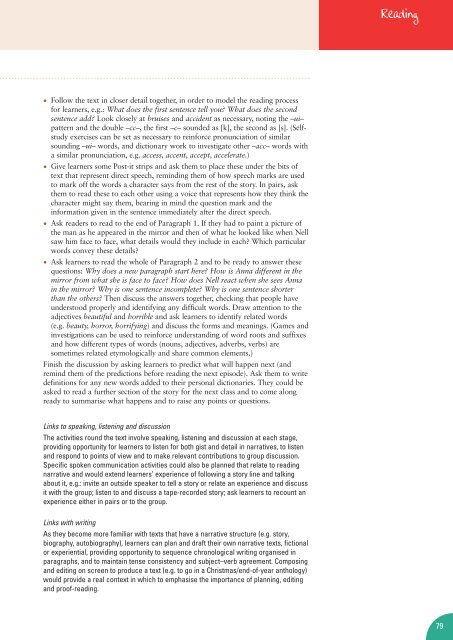Adult Literacy Core Curriculum - Nationally developed Skills for Life ...
Adult Literacy Core Curriculum - Nationally developed Skills for Life ...
Adult Literacy Core Curriculum - Nationally developed Skills for Life ...
You also want an ePaper? Increase the reach of your titles
YUMPU automatically turns print PDFs into web optimized ePapers that Google loves.
• Follow the text in closer detail together, in order to model the reading process<br />
<strong>for</strong> learners, e.g.: What does the first sentence tell you? What does the second<br />
sentence add? Look closely at bruises and accident as necessary, noting the –ui–<br />
pattern and the double –cc–, the first –c– sounded as [k], the second as [s]. (Selfstudy<br />
exercises can be set as necessary to rein<strong>for</strong>ce pronunciation of similar<br />
sounding –ui– words, and dictionary work to investigate other –acc– words with<br />
a similar pronunciation, e.g. access, accent, accept, accelerate.)<br />
• Give learners some Post-it strips and ask them to place these under the bits of<br />
text that represent direct speech, reminding them of how speech marks are used<br />
to mark off the words a character says from the rest of the story. In pairs, ask<br />
them to read these to each other using a voice that represents how they think the<br />
character might say them, bearing in mind the question mark and the<br />
in<strong>for</strong>mation given in the sentence immediately after the direct speech.<br />
• Ask readers to read to the end of Paragraph 1. If they had to paint a picture of<br />
the man as he appeared in the mirror and then of what he looked like when Nell<br />
saw him face to face, what details would they include in each? Which particular<br />
words convey these details?<br />
• Ask learners to read the whole of Paragraph 2 and to be ready to answer these<br />
questions: Why does a new paragraph start here? How is Anna different in the<br />
mirror from what she is face to face? How does Nell react when she sees Anna<br />
in the mirror? Why is one sentence incomplete? Why is one sentence shorter<br />
than the others? Then discuss the answers together, checking that people have<br />
understood properly and identifying any difficult words. Draw attention to the<br />
adjectives beautiful and horrible and ask learners to identify related words<br />
(e.g. beauty, horror, horrifying) and discuss the <strong>for</strong>ms and meanings. (Games and<br />
investigations can be used to rein<strong>for</strong>ce understanding of word roots and suffixes<br />
and how different types of words (nouns, adjectives, adverbs, verbs) are<br />
sometimes related etymologically and share common elements.)<br />
Finish the discussion by asking learners to predict what will happen next (and<br />
remind them of the predictions be<strong>for</strong>e reading the next episode). Ask them to write<br />
definitions <strong>for</strong> any new words added to their personal dictionaries. They could be<br />
asked to read a further section of the story <strong>for</strong> the next class and to come along<br />
ready to summarise what happens and to raise any points or questions.<br />
Links to speaking, listening and discussion<br />
The activities round the text involve speaking, listening and discussion at each stage,<br />
providing opportunity <strong>for</strong> learners to listen <strong>for</strong> both gist and detail in narratives, to listen<br />
and respond to points of view and to make relevant contributions to group discussion.<br />
Specific spoken communication activities could also be planned that relate to reading<br />
narrative and would extend learners’ experience of following a story line and talking<br />
about it, e.g.: invite an outside speaker to tell a story or relate an experience and discuss<br />
it with the group; listen to and discuss a tape-recorded story; ask learners to recount an<br />
experience either in pairs or to the group.<br />
Links with writing<br />
As they become more familiar with texts that have a narrative structure (e.g. story,<br />
biography, autobiography), learners can plan and draft their own narrative texts, fictional<br />
or experiential, providing opportunity to sequence chronological writing organised in<br />
paragraphs, and to maintain tense consistency and subject–verb agreement. Composing<br />
and editing on screen to produce a text (e.g. to go in a Christmas/end-of-year anthology)<br />
would provide a real context in which to emphasise the importance of planning, editing<br />
and proof-reading.<br />
Reading<br />
79

















